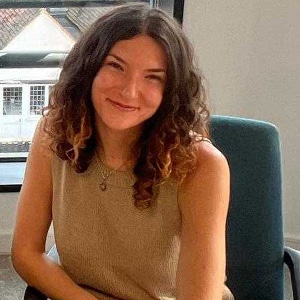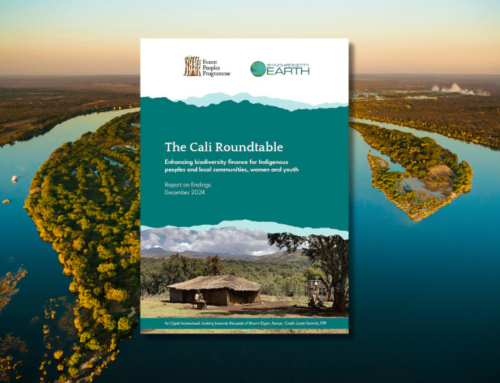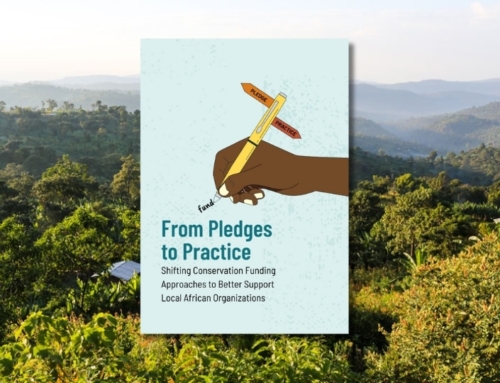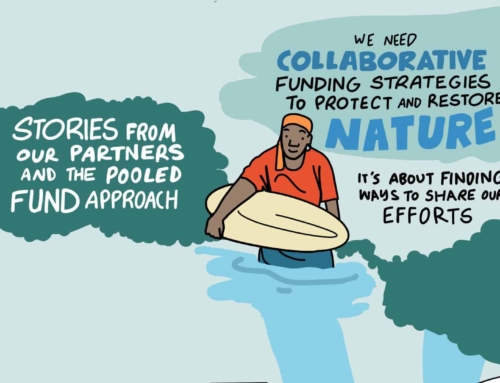In 2021, at the COP26 climate summit in Glasgow, a group of environmental conservation donors made a historic $1.7 billion pledge to support Indigenous Peoples’ and local communities’ forest guardianship. But getting conservation funding to lndigenous or local community-led groups can be a challenge, particularly for larger funders.
Commissioned by the Ford Foundation on behalf of the Forest Tenure Funders’ Group, Indufor’s report, ‘Forging Resilient Pathways: Scaling up Funding in Support of Indigenous Peoples’ and Local Communities’ Tenure and Forest Guardianship in the Global South’ explores some of the obstacles funders face in reaching the most effective, locally led organisations, and offers recommendations and practical guidance to donors on how to overcome those obstacles.
Here we take a look at some key findings from the report and explore some of the approaches it highlights, including Synchronicity Earth’s own Pooled Fund model.
The funding dilemma
There is growing recognition among many funders that the knowledge, culture, and practices or lifeways of Indigenous Peoples and local (territorial) communities need to be at the heart of our response to the current environmental crises we are facing. But for this to happen, we must start by recognising that the rights of Indigenous Peoples and local communities need to be advanced and protected. Fortunately, there are organisations taking steps to achieve this.
However, there is a huge shortfall in the amount of conservation funding reaching Indigenous Peoples and local communities. In fact, donors have initially reported that only around 7% of the $1.7 billion pledge has gone directly to Indigenous communities. Further studies have revised that figure to less than 3%. With larger funders struggling to get effective funding to those working on the ground, local organisations are not getting the resources they need to do their work.
Supporting the pledge
The report’s main purpose is to help large pledge donors fund Indigenous Peoples and local communities by providing practical guidance, strategic insights and examples of best practice. As more large donors are given the tools and approaches to fund these groups effectively, the hope is that this will increase the flow of much needed funding to the places and organisations where it can have most impact.
Presenting the first global analysis of this kind, the report encompasses a range of approaches to tackle the funding dilemma. It draws on case studies from three types of organisations: Indigenous-led funders like Pawanka, re-grantors like Synchronicity Earth and Fundo Casa, and groups who focus on developing organisational capacity, such as Maliasili.
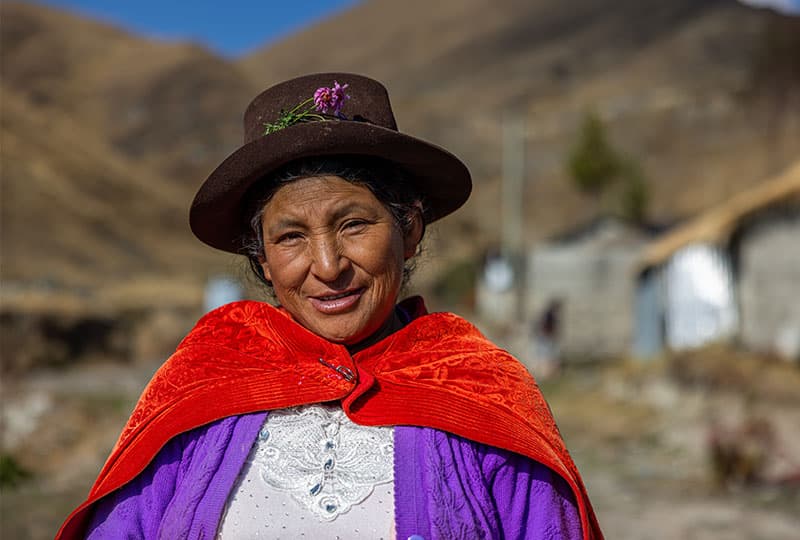
Asociación Pro Fauna Silvestre work to promote Indigenous rights, environmental management, and research in Ayacucho, Peru. They are one of five partners supported by pooled funding to attend the Latin American Congress of Herpetology. © Chris Scarffe
Making funding more effective
Assessing the current models which channel resources to communities and organisations, the report pulls out several barriers and offers advice on how to overcome them. For instance, a barrier to successful forest management funding is that Indigenous and local groups have often lacked the power and necessary channels to state their own needs, goals and priorities – instead, decisions are ‘top-down’ and donor driven. As such, the outcomes are often poorly aligned with the needs of the community, and their benefit is limited.
Pawanka tackles this by empowering communities to approach organisations, accepting proposals based on an Indigenous group’s self-identified needs. Communities conduct their own needs assessments, and Pawanka staff work with partners to support them to develop proposals.
Meanwhile, Fundo Casa does not hold open calls for proposals, but instead uses its own networks and deep local knowledge to build partnerships. As well as reducing burdens on grantees, this approach delivers timely and strategically targeted funds.
Other suggestions include:
- Building strong local groups by investing in organisations as a whole, rather than just short-term projects;
- Accepting proposal submissions and reports in local languages or through video to reduce power imbalances; and
- Providing space for local organisations to coordinate, sharing strategies and data.
The Synchronicity Earth approach
We are proud to have been recognised for the work we are doing to empower communities and Indigenous Peoples to defend their territories and the biodiversity within them.
The case study featuring Synchronicity Earth describes the work of our Congo Basin Programme and in particular, the ‘pooled fund’ approach it has taken since 2017. Based on interviews with Synchronicity Earth staff, our Congo Basin partners, other funders, and affiliates, various key elements of practice were highlighted in the report, including:
- Our innovations in relationship-building and prioritising relationships built on mutual trust to enable a shift away from traditional top-down approaches. Partner organisations highlighted Synchronicity Earth as one of the best funders they work with when it comes to providing them with discretion to use funds as they see fit.
- Clear and systematic risk assessment to go beyond only funding ‘safe’ organisations. Effective risk mitigation allows us to support brilliant and underfunded conservation groups working in ‘higher-risk’ contexts like the Congo Basin.
- Investment in frontline organisations as a whole to deliver greater impact, with longer-term, strategic funding offering durable and sustainable results.
- Streamlining administration processes to reduce ‘red tape’ paperwork for our partners.
- An emphasis on core support to address needs like administration, staff salaries, organisational infrastructure and, where appropriate, supporting organisations on the path to legal status. The programme also maintains an emergency facility to support partners in times of dire need.
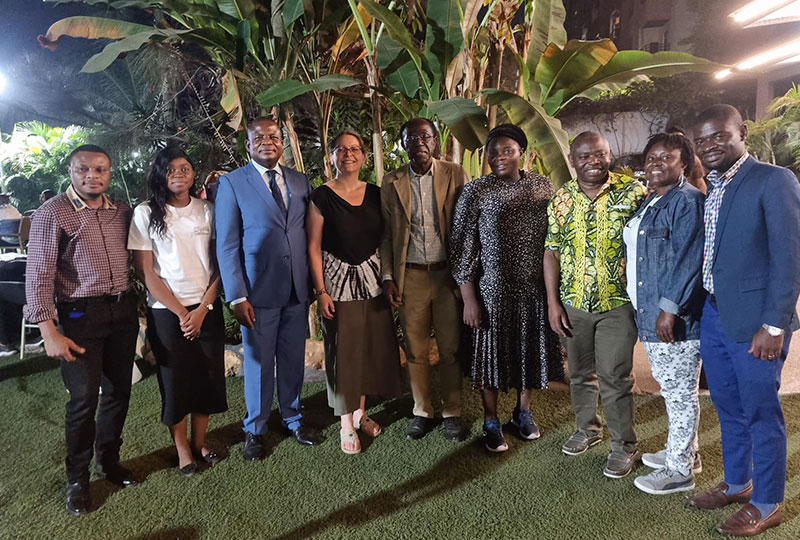
Sophie Grange-Chamfray, our Learning and Knowledge Lead, with Affiliate Bihini Won wa Musiti at a dinner organised by Synchronicity Earth for its Congo Basin partners in Kinshasa.
Benefits of the Pooled Fund
Our ‘pooled fund’ approach supports our Congo Basin Programme to provide partners with core support and funding for capacity building. The key benefit of this approach, as described by the report, is that it reduces the burden on both donors hoping to fund a limited-capacity organisation and on partners trying to secure funding:
“Synchronicity Earth’s pooled fund model buffers frontline organisations from donor fragmentation. Funding is pooled from several donors and passed directly to local organisations, meaning that local groups are able to secure sufficient funding while being accountable to only a single funder.”
The funding we secure is given directly to our partners working to enact change on the ground. This lightens the administrative workload for small organisations that often have limited staff and resources, increasing the amount of time available for valuable field conservation and community engagement. By delivering much-needed, long-term and consistent funding, we support the growth and capacity of our partners and help to build resilience.
Donations to this fund, though restricted to the programme, are flexible and – in consultation with partners and affiliates who understand local issues – can be spent at our discretion. These discussions ensure alignment between the strategic focus of donors and the needs of partners.
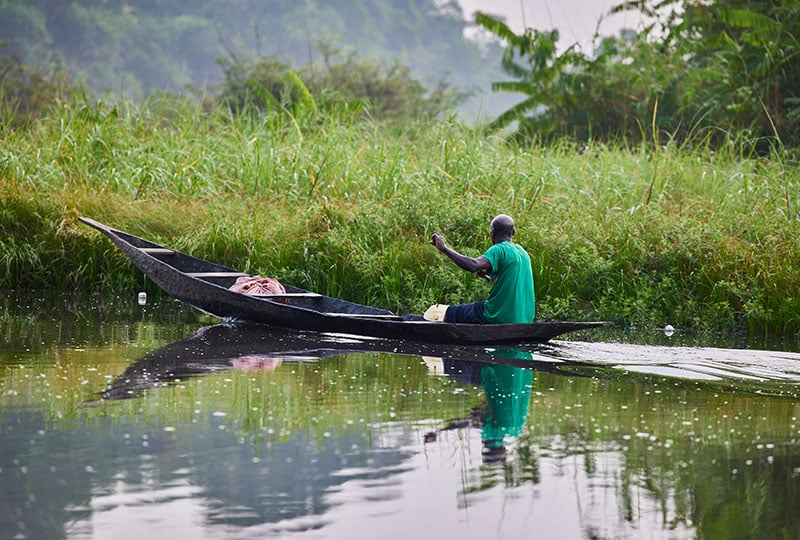
A local fisherman on Cameroon’s Nkam river, captured when Congo Basin Affiliates joined a field trip with the African Marine Mammal Conservation Organisation (AMMCO), who work to improve environments for marine wildlife. © Hermann Peka
The model also helps to give donors the opportunity to co-fund, meeting shared thematic and geographic goals, and create strong relationships built on trust, meaning donors often increase their contributions over time.
The report described our Congo Basin Pooled Fund as an approach that can potentially be developed, replicated, and scaled up elsewhere, and we hope to see more donors and organisations opting for this kind of conservation funding approach.
The Congo Basin Pooled Fund has paved the way for further pooled funds supporting our work. For example, we have a well-established pooled fund supporting our Amphibian Programme, and in 2023 we launched our Chrysalis Youth Fund, which supports young environmental leaders in the ‘Global South’ working at the intersection between youth and Indigenous advocacy. We are also currently developing a pooled fund for our Freshwater Programme and aim to develop further pooled funds over the next few years.
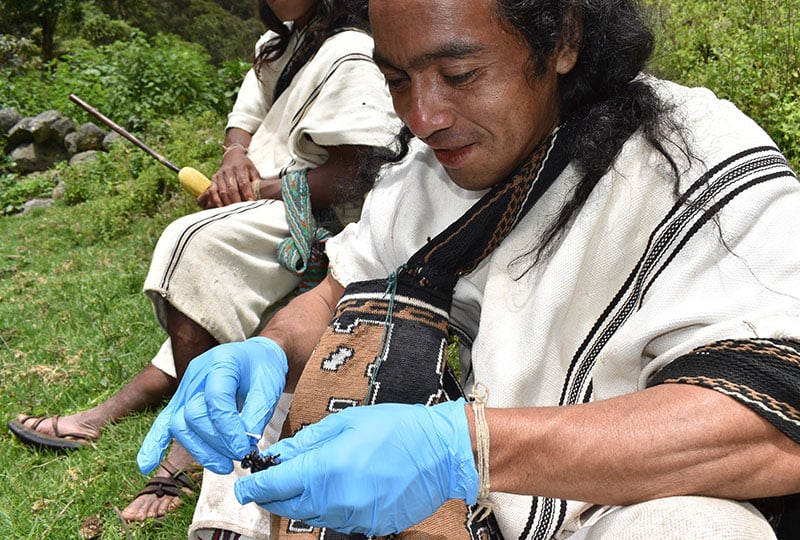
The Amphibian Programme’s pooled fund supports Fundación Atelopus to use the Traditional Ecological Knowledge of Sogrome’s Arhuaco community to identify why the starry night harlequin toad population they care for survived the fungal disease chytrid. © Fundación Atelopus
Committing to reciprocal learning
Aware of the challenges of the donor-grantee relationship, we are working to create more equitable partnerships. Open, flexible and trust-based relationships are at the heart of our conservation programmes. It is what allows us to empower locally led initiatives to make a real difference in their communities.
As an intermediary (re-grantor), it is essential to reflect on and adapt our approach – regular discussions help us respond to our partners’ needs. We try to reduce barriers by changing complex proposals to simple questions in local languages and developing tools so communities can define their own activities.
Typical Monitoring, Evaluation and Learning (MEL) frameworks are based on donors’ desires for impact/outcome reporting and can be time-consuming, often lacking the ‘bigger picture’. However, one of our case study highlights was for ‘innovations in participatory monitoring and reporting’. This relies on a commitment to letting Indigenous and local communities lead and making processes more inclusive. That is why we have taken steps to include storytelling as a way for partners to capture their progress in a format that is meaningful for them, as the report states:
“Synchronicity Earth’s MEL system based on storytelling and community-developed indicators has strengthened partners’ ability to monitor progress and generate learnings.”
Sophie Grange-Chamfray, our Knowledge & Learning Manager and Congo Basin Programme Lead, explains: “How we define, perceive and assess impact varies widely across ecological and cultural contexts. Our participatory MEL approach enables us to use both classical MEL systems and more inclusive tools, such as storytelling – widely used by Indigenous Peoples and local communities to assess changes and share knowledge. Promoting the use of traditional knowledge in impact assessments is creating new ways to fund conservation on the ground.”
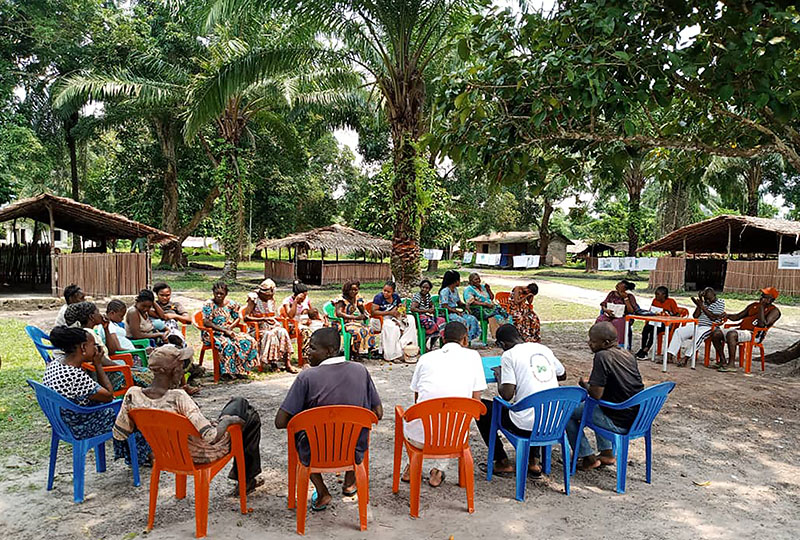
A local community during discussions with SOFFLECO, an association developed by Femmes Solidaires (FESO), who Synchronicity Earth has worked with since 2018 to protect the Congo River and its communities. © FESO
Scaling up funding: A shared goal
It is encouraging to see the positive steps these organisations are taking, including those we share in common in our role as a re-grantor. Though Synchronicity Earth is committed to finding the most effective ways to fund grassroots groups, we recognise that if we act alone, our impact will always be limited. If we want to change the sector for the better, we need sector-wide collaboration.
As Synchronicity Earth Co-Founder Jessica Sweidan says: “We are honoured to be part of this learning journey with others who are working to challenge the sector we coexist in, moving from dominant approaches which no longer serve us.
These are just the first steps in moving towards better funding models, but that’s why this report is so important. The examples of best practice provide a framework for funders, highlighting models and ways of doing that centre Indigenous and local communities. Ultimately, the report shows that, with collaboration, better funding is possible and I hope this helps turn pledges into action.”
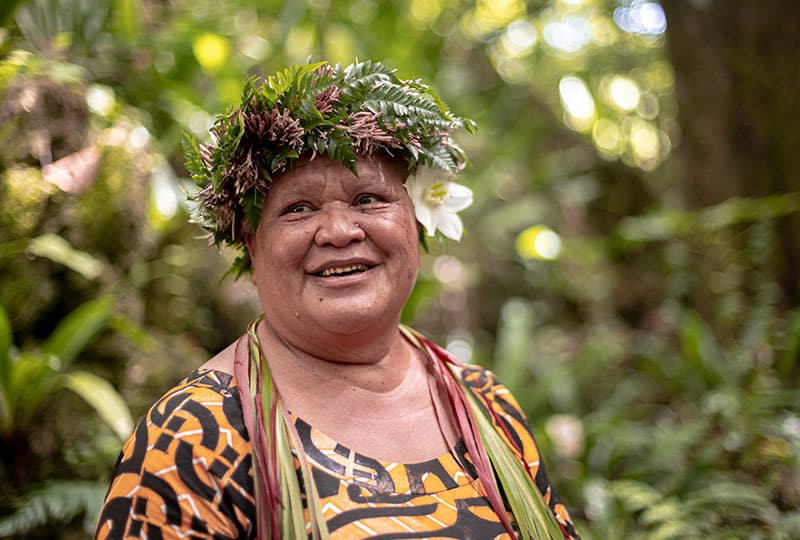
Our Biocultural Diversity Programme helps Indigenous and local community organisations like Kōrero O Te`Ōrau, Cook Islands, preserve their culture, environment, and natural resources. © Kōrero O Te`Ōrau
Moving forward together
We hope that by sharing these examples of best practice, the report’s findings will help to guide how funding is channelled in future, so it reaches where it is needed most. But we cannot just hope, waiting for the ‘domino effect’ to take place. With many Indigenous and local communities facing huge battles, including forced evictions from the ancestral lands they preserve, financial support is more important than ever. Systemic change to funding distribution which, ideally, would filter up to the governmental level, is urgently needed.
Committing more finance now to support capacity building, collective governance structures, and sustainable livelihoods – as well as activities that strengthen Indigenous land and resource rights such as community mapping – makes these changes more achievable.
Moving forward, we aspire to provide more longer-term funding to more local and national organisations, supporting them with core and flexible funding to develop and grow. And if large donors and conservation groups take the report’s learnings on board to harness these approaches, more can be done to protect our planet, including the people looking after it.
Our Reimagining Philanthropy Working Group is focused on the question of how to adapt current funding models to address innate power imbalances within philanthropy.
If you are a funder and would like to learn more about this work, or our pooled fund model, please get in touch.

